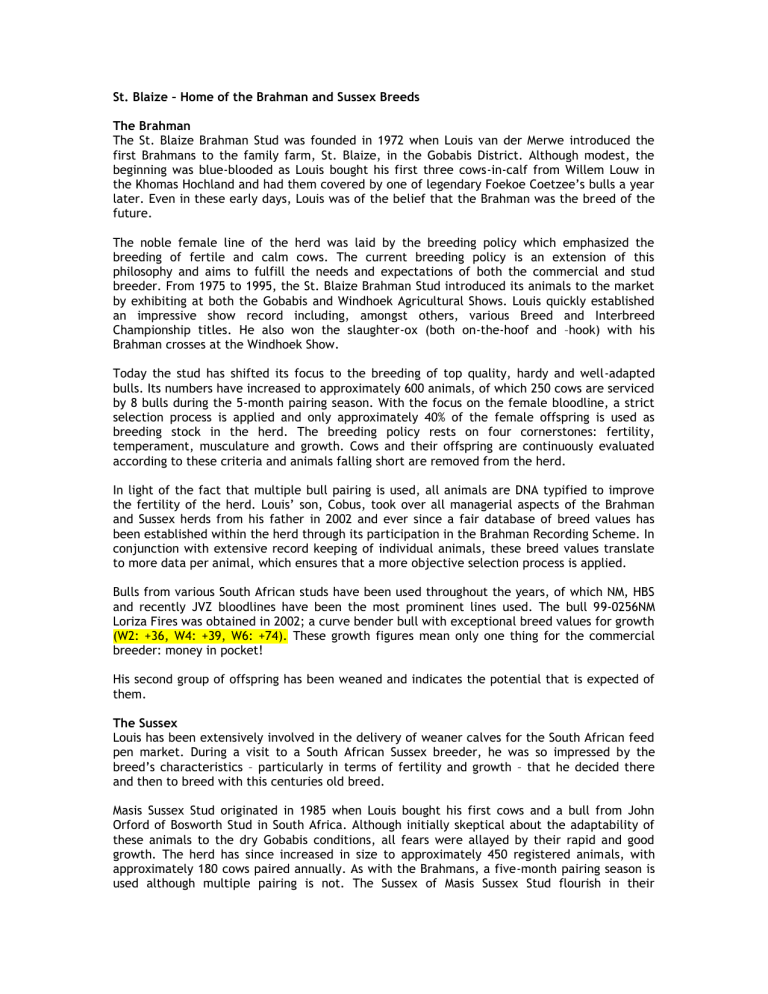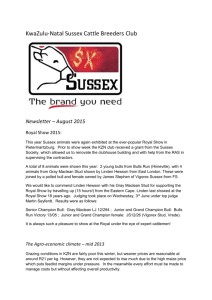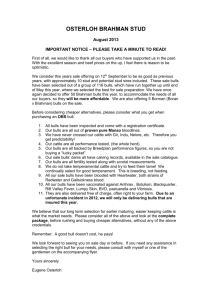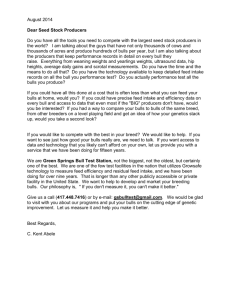Home of the Brahman and Sussex Breeds

St. Blaize – Home of the Brahman and Sussex Breeds
The Brahman
The St. Blaize Brahman Stud was founded in 1972 when Louis van der Merwe introduced the first Brahmans to the family farm, St. Blaize, in the Gobabis District. Although modest, the beginning was blue-blooded as Louis bought his first three cows-in-calf from Willem Louw in the Khomas Hochland and had them covered by one of legendary Foekoe Coetzee’s bulls a year later. Even in these early days, Louis was of the belief that the Brahman was the breed of the future.
The noble female line of the herd was laid by the breeding policy which emphasized the breeding of fertile and calm cows. The current breeding policy is an extension of this philosophy and aims to fulfill the needs and expectations of both the commercial and stud breeder. From 1975 to 1995, the St. Blaize Brahman Stud introduced its animals to the market by exhibiting at both the Gobabis and Windhoek Agricultural Shows. Louis quickly established an impressive show record including, amongst others, various Breed and Interbreed
Championship titles. He also won the slaughter-ox (both on-the-hoof and –hook) with his
Brahman crosses at the Windhoek Show.
Today the stud has shifted its focus to the breeding of top quality, hardy and well-adapted bulls. Its numbers have increased to approximately 600 animals, of which 250 cows are serviced by 8 bulls during the 5-month pairing season. With the focus on the female bloodline, a strict selection process is applied and only approximately 40% of the female offspring is used as breeding stock in the herd. The breeding policy rests on four cornerstones: fertility, temperament, musculature and growth. Cows and their offspring are continuously evaluated according to these criteria and animals falling short are removed from the herd.
In light of the fact that multiple bull pairing is used, all animals are DNA typified to improve the fertility of the herd. Louis’ son, Cobus, took over all managerial aspects of the Brahman and Sussex herds from his father in 2002 and ever since a fair database of breed values has been established within the herd through its participation in the Brahman Recording Scheme. In conjunction with extensive record keeping of individual animals, these breed values translate to more data per animal, which ensures that a more objective selection process is applied.
Bulls from various South African studs have been used throughout the years, of which NM, HBS and recently JVZ bloodlines have been the most prominent lines used. The bull 99-0256NM
Loriza Fires was obtained in 2002; a curve bender bull with exceptional breed values for growth
(W2: +36, W4: +39, W6: +74). These growth figures mean only one thing for the commercial breeder: money in pocket!
His second group of offspring has been weaned and indicates the potential that is expected of them.
The Sussex
Louis has been extensively involved in the delivery of weaner calves for the South African feed pen market. During a visit to a South African Sussex breeder, he was so impressed by the breed’s characteristics – particularly in terms of fertility and growth – that he decided there and then to breed with this centuries old breed.
Masis Sussex Stud originated in 1985 when Louis bought his first cows and a bull from John
Orford of Bosworth Stud in South Africa. Although initially skeptical about the adaptability of these animals to the dry Gobabis conditions, all fears were allayed by their rapid and good growth. The herd has since increased in size to approximately 450 registered animals, with approximately 180 cows paired annually. As with the Brahmans, a five-month pairing season is used although multiple pairing is not. The Sussex of Masis Sussex Stud flourish in their
surroundings and a calf percentage above 85% has been maintained over the past years. The animals are furthermore characterized by superb precocity and exceptional growth until 600 days. Sussex calves have to be weaned at least a month before the Brahman calves as they start to reach sexual maturity at 7 months and bulls and heifers must be separated from one another. This year’s calves attained an average weaner-weight of 243 kg at 190 days.
As with the Brahmans, great emphasis is placed on the female line and a strict selection process is also applied. The breeding policy is founded in fertility, precocity, growth and adaptability. There are currently five active bulls in the herd, of which one is self-bred. The other bulls were bought from South African breeders, with the most recent acquisition a South
African Junior Champion bull, ARE01-099, from Skietlaagte Stud.
By its nature, the high fertility, exceptional growth and tame temperament of the Sussex make it a most profitable animal with which to farm. Yet another great advantage, derived from the age of the breed, is that it is virtually without genetic faults that plague many other breeds. Of importance for the weaner calf producer is that the Sussex breed is amongst the small, selective group of breeds from which large South African supermarket chains only buy meat.
These supermarkets are prepared to pay a premium in order to stock their shelves with only the finest meat; this means that in the future weaner calf producers may possibly be compensated at varying tariffs according to the breed of the calf.
Production Auction
Louis and Cobus are proud to announce that their 10 th Brahman & Sussex Auction will be held at the farm St. Blaize on 16 September. On offer are a total of 22 white Brahman bulls and 18
Sussex bulls of the highest quality.
According to Louis, one of the greatest achievements of his stud-breeding career is the fact that breeders return year after year to buy bulls at his auction. Since the first auction in 1996, precise bookkeeping has been maintained of all bulls sold and buyers and of the current total of 256 bulls offered, 251 were sold. A glance at the buyers’ list shows that an impressive 60% have bought their bulls from Louis on more than one occasion. This is indeed testament to the
“Cattle-man” from the Gobabis District and the quality of genetic stock offered. Louis and
Cobus would like to thank their loyal buyers for their support and invite other farmers to also become a part of the St. Blaize Brahman and Masis Sussex family.
The auction facilities established over the years are truly remarkable and it is a pleasure to spend the third Friday of each September on Farm St. Blaize!
Photo caption: The white Brahman has been established on St. Blaize for almost 33 years.
Photo caption: Quality bulls such as this are the result of a breeding policy that emphasizes fertility, precocity, growth and adaptability. Prospective buyers can expect no less than these standards of quality at the forthcoming auction.
Photo caption: Over the years, the van der Merwes have invested in a phenomenal auction facility on the farm itself.
Photo caption: In addition to the family’s strong ties to the Brahman and Sussex, Cobus
(standing) is active in the Namibia’s Saddle Horse industry and his wife, Angie, recently started her own Friesian Stud. Louis and his wife, Marlene, are seated.





